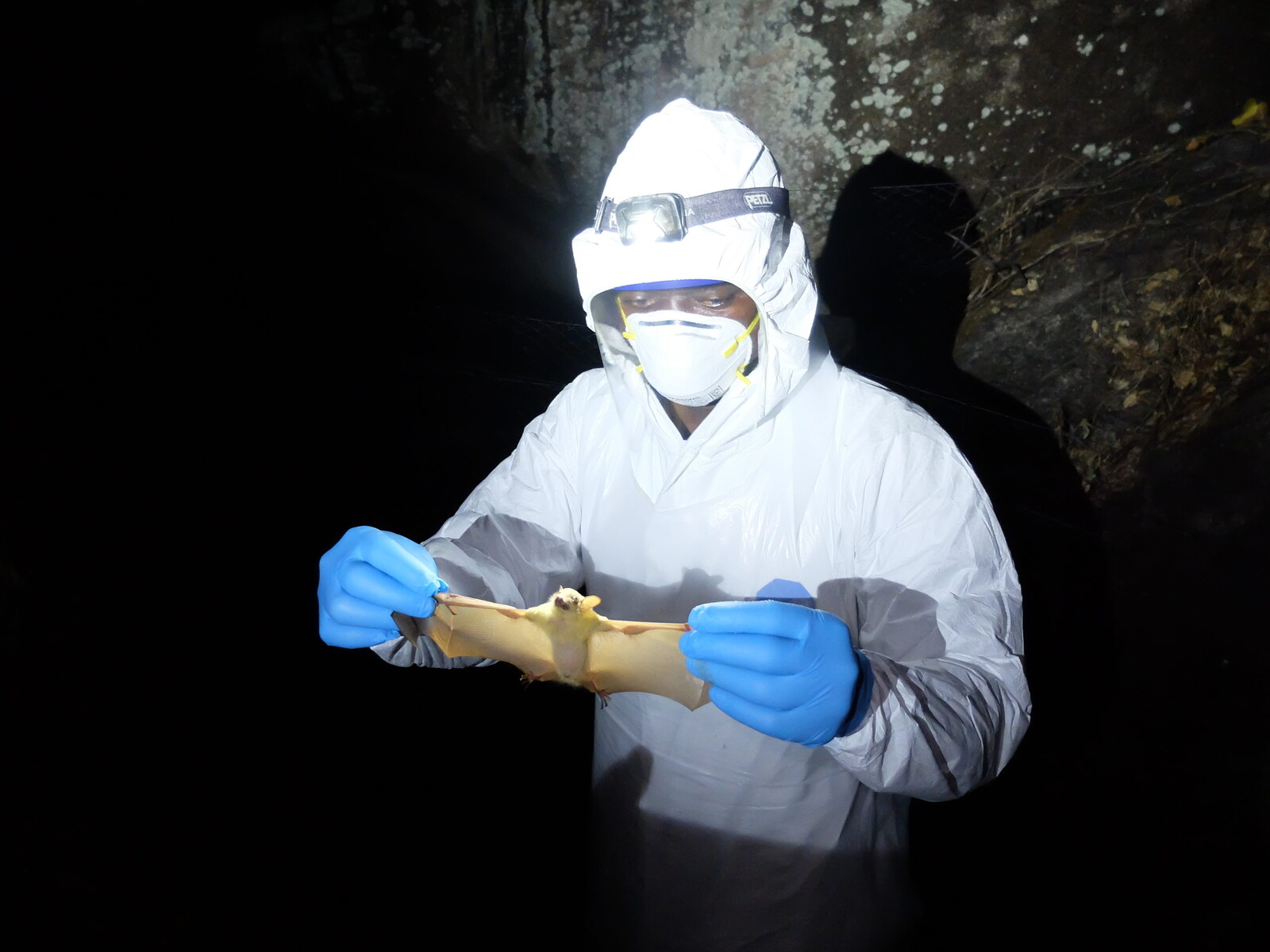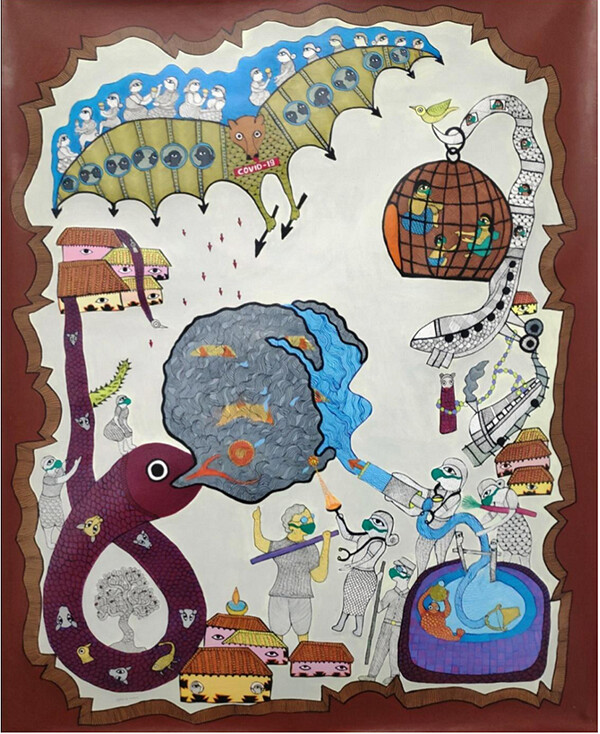

Subhash Vyam, Corona.
A giant bat swoops down into one of Subhash Vyam’s paintings, carrying a string of conversing humans on its wings. Ashen human faces peep out from inside of the wings’ folds, perhaps sick, perhaps dead. Its intentions made clear by a series of arrows, the bat, labelled Covid-19, seems poised to drop the humans into a huge ball of fire spat out by a two-headed snake. Bats, animals that harbor several coronaviruses, have been recognized since early in the pandemic as a likely natural reservoir of SARS-CoV-2. Media outlets all over the world latched on to this theory and published bat images alongside stories on Covid-19. Early scientific evidence linked SARS-CoV-2 to a coronavirus previously isolated to horseshoe bats (Rhinolophus pusillus) in China, Indonesia, Laos, Malaysia, Myanmar, Nepal, Thailand, and Vietnam.1 As a recent World Health Organization report on the origins of SARS-CoV-2 reiterates, given that the bat hypothesis is based almost exclusively on evidence from comparative genomics, it remains only a probability.
Subhash Vyam, an artist from the Indigenous Gond community of central India, lives and works in Madhya Pradesh. Entering Vyam’s 2021 painting means wandering through a landscape that is both surreal and easily identifiable. The two-headed snake carries in its body a plethora of other animals—birds, cattle, a cheetah, a scorpion as it writhes around a cluster of huts. The huts have large, fearful eyes and look out at the world, silhouettes of diyas (terracotta lamps) on their walls, signaling a huddled solidarity with all those taking shelter indoors. Medical workers, policemen, and politicians in green surgical masks rally around the fire, drawing liquid from a well. A syringe, a reference to the vaccine, doubles as a hose. A turtle does its bit to help direct the course of the life-saving liquid. Wealthy, city-dwelling humans are locked up in cages. A wobbly, scaly airplane full of passengers remains chained to a post with a rather forlorn-looking animal head. The scale of objects, humans, and animals in Vyam’s painting disorients the viewer. Elements of his canvas loom and scuttle. Animals inhabit other animals, airplanes merge into trains, allowing a perhaps unexpected multiscalarity that collapses the individual multispecies body, the social body, and the body politic. Vyam makes visible the relationality of the elemental, microscopic, human, animal. Unlike other artists, Vyam does not give the virus itself shape and form. Instead, he focuses on what unfolds around him at multiple scales.
Seeing is a political act. In this essay, by looking at, through, and around images produced in response to the Covid-19 (and other pandemics) by artists in India and Australia, I think through the politics of visualizing and visibility. Who has the right to visualize what and how? I am interested not just in the ways that scientists, artists, and people in their everyday lives have made the virus visible but also in what other processes—both historical and contemporary—viruses make visible. These processes include longstanding inequalities related to access to resources and healthcare, as well as vaccine imperialism and xenophobia. As Vyam’s painting illustrates, how we look at images as well as the world in modern life is not only political but also embedded in structures of global capital.
Anna Tsing’s notion of “spectacular accumulation” occurs when investors speculate on a product that may or may not exist. It is made possible by the cooperation of global finance capital and smaller-scale national and regional corporatism. It is, as Tsing reminds us, not new but a continuation of the South Sea bubble and every gold rush in history.2 In yoking the contemporary neoliberal order back to colonial capital expansion, the origins of Tsing’s spectacular accumulation in specere (to look) makes me pause and reflect on how looking is embedded in historical and contemporary forces of capital, both regional and global. Guy Debord’s theory of the spectacle argues that in modernist society, the idea of being was recast into the idea of having, thus creating consumers rather than beings. Indigenous communities in India and elsewhere have been routinely classified as “primitive,” their ways of life and value seen as separate from those of the modern world. However, in the artworks I discuss, the act of visualizing the virus brings together the mythical and mundane, reminding us that both are political, inherently globalized, and actively a part of a neoliberal economic order. To think of the ways in which different communities, especially Indigenous communities, visualize the coronavirus today is to also delve into longer histories of seeing, of colonialism, and the spread of infection.


Copy of Robert Hooke’s original compound microscope as described in his “Micrographia” (1665). Courtesy Science Museum Group Collection.
The European Enlightenment thirst for seeing and knowing things gave rise to the illustration of microorganisms, unseen to the human eye. It was the application of early modern scientific methods in Europe that allowed European powers to infiltrate a diverse range of distant regions and served as a precursor to settler colonialism, slavery, and various modes of the domination of natural phenomena—which in their eyes included climates, land, flora, fauna, and native peoples. This was the beginning of a connected, globalized world in which the flow of people and goods was mandated first by a mercantilist and colonial economy, then gradually an expanding capital-driven international market. The scaling-up of invisible organisms coincided, therefore, with the scaling-up of the world—from local self-sufficient communities to a set of global interdependencies. The same impulse that allowed humans to see the unseeable, which equipped us with the tools with which we visualize the virus today, also laid the foundations for its existence and global proliferation.
The English words “contagion,” “contingent,” and “contact” all share the same Latin root (con: together, tangere: to touch). I am interested in how contagion is dependent on the contingency of structural inequalities and global capitalism (which inform all public policy decisions). Contact, in the settler-colonial sense of first contact as well as in the question of who must touch what, runs through the course of this essay. In India, waste-workers are primarily Dalit, making both caste and other structural inequalities in the time of global capital force touching and close contact for some, while allowing for the privilege of social distancing for others. Displacement and migration are forces on which the spread of contagion is often contingent.


ASHAs in Haryana protest for better pay & testing facilities during the Covid pandemic. Courtesy HARYANA ASHA WORKERS UNION.
Contagion: The Mythical and the Mundane
The Gond are Adivasis (original inhabitants), one of the largest Indigenous groups in India. In British India, different Indigenous groups were brought together under one umbrella category of “primitive” Scheduled Castes and Tribes and described as “aboriginals” or “early tribes” because of their “clan”-based systems of kinship and their “animistic” religious beliefs. The image of the Adivasi as primitive and backward persisted in the national imagination even after India gained independence from the British and strode into modernity. In fact, the sense that India as a nation housed oft-romanticized “primitive” groups fueled parts of liberal nationalist postcolonial discourse. More recently, as the government continues to encroach on Adivasi land, and mining companies decimate it, the figure of the Adivasi as environmental activist and a defender of nature circulates in the art world and left-liberal circles. The profusion of trees and animals, all of whom are thinking, active creatures in paintings like Vyam’s, speak as much to what is intrinsic to the Adivasi way of life as it does to the loss of it. Having been displaced multiple times, by the British colonial government and successive Indian governments and corporations, and working mainly as day laborers, Gond and other Adivasi communities continue to live in imagined forests as much as real ones.


Laxman Nayak or Laxman Naik (November 22, 1899–March 29, 1943) was a tribal civil rights activist from South Odisha in eastern India.
The way multispecies relations feature in Vyam’s painting is significant. Zoonoses are diseases that spread from nonhuman animals to humans and have been recognized as a cause of infectious disease epidemics and pandemics since at least the late nineteenth century. Robert Webster and Graeme Laver’s late-twentieth-century discovery of the way in which the influenza virus migrated from birds, mutating into a form that is infectious to humans, transformed the historical understanding of the epidemiology of the influenza epidemic of 1918. In the 1980s, the anthropologist and historian David Hardiman conducted interviews in Adivasi villages in Western India to find that an oral-history memory of that epidemic lingered on. Remembered as mānmodi, it wiped out entire households and suddenly killed large portions of one village. For these communities, the lack of proper funerals for the dead was thought to be extremely inauspicious and gave rise to fears of what further tragedies future years might bring. As Hardiman writes, one of the people he interviewed claimed that people in his village continued to suffer for five years afterwards. This is in keeping with later findings that severe bouts of influenza can affect the central nervous system. It has been suggested that there was a direct link between the influenza epidemic and a subsequent wave of encephalitis lethargic (EL), or sleepy sickness, that killed around five million people across the world in the 1920s.3 Adivasis in Western India were particularly susceptible to the virus that ravaged their communities in 1918 because of chronic malaria, poor diet, sanitation, undiagnosed sickle-cell anemia, and general levels of poverty, all of which weakened immune systems. While some missionary outposts provided local relief, overall the British colonial state failed to provide healthcare or medical guidance to these communities. Studies have shown that Indigenous groups all over the world saw particularly high mortality rates during the epidemic, including Native Americans and the Inuit peoples of Canada and Alaska, and the Maori in New Zealand. It decimated populations in the Pacific Islands, with around 5 percent of the population dying in Fiji, 10 percent in Tonga, and 25 percent in Western Samoa.4 The Covid-19 pandemic raised similar concerns for Indigenous communities across the world.
Gond art is not an ancient art form, but a constructed tradition. The artist Jangarh Shyam, Subhash Vyam’s brother-in-law, first translated the rich oral lore into canvas, borrowing Digna patterns that were originally used by Gond women to decorate the floors and walls of houses. In the early 1980s, Jangarh met and worked with the Indian artist and writer Jagdish Swaminathan, who established Bharat Bhavan, an arts complex that housed “tribal and folk” art. Jangarh died by suicide while on a residency in Japan. Generations of Gond artists continue to keep Gond art, or what is probably more aptly called “Jangarh Kalam” (the style of Jangarh), alive. The Pardhan Gonds borrow freely from Adivasi folklore, centering much of their work on trees and animals, Gond gods and goddesses (as well as a pantheon of Hindu ones), and their own lives, creating a lived experience that reflects not a “pure” Indigenous experience but one that is about living-with. The work reflects realities of living-with loss, Hindu fundamentalism, urban land grabs, extreme poverty, and viruses. Adivasi art in India remains a tourist commodity, not yet fully recognized by the boom in investment-oriented art and galleries that first emerged in India in the 1990s. As scholar Rashmi Varma argues, “Their ‘primitive’ roots open them up to niche investments, as exemplified by the new crop of ‘craft entrepreneurs’ in the metropolitan centres.”5 It is helpful to see Vyam’s painting as both beholden to and critical of the processes of global capital.
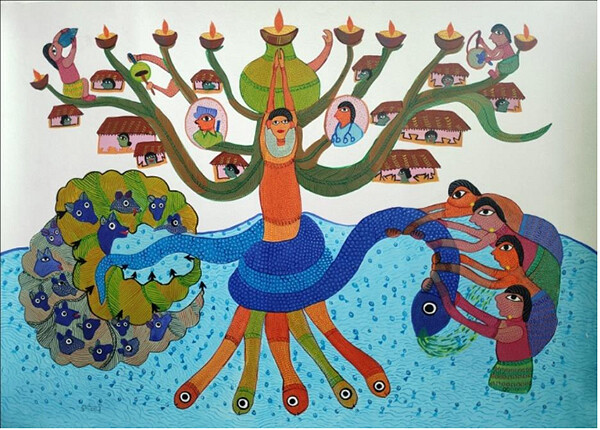

Durgabai Vyam, Corona Samundramanthan.
Made around the same time as Subhash Vyam’s Corona, a painting by Durgabai Vyam called Corona Samundramanthan looks to an episode in Hindu mythology known as the churning of the oceans to draw parallels of the kind of flux the pandemic engendered. In the mythological account, during a standoff between the devas (gods) and the asuras (demons), the naga (half-human, half-cobra) Vasuki was used as the rope that churned the ocean. The asuras held its head and the devas held its tail. In Durgabai’s painting, what she describes as the poisonous Corona snake takes the place of the naga and is tugged by a swarm of bats on the left and a group of humans on the right. The “Corona snake” emits poison from its mouth in a reference to halahala, a deadly poison that gave off lethal fumes and had the potential to destroy all beings. Durgabai’s painting is both plaintive and optimistic. The mythological churning of the oceans was a means for the devas (gods) to attain amrita (the elixir of immortality), which they eventually did.
Capturing a smidge of human history and collapsing it into mythological time and space, Durgabai’s depiction of the tree of life (a recurring motif of Gond painting) records very particular details from India’s first wave of Covid. Doctors, nurses, and policemen have their special place on the branches of the tree as houses hang suspended, their inhabitants locked in and gray-green. Durgabai locates her scene in a contemporary Gond village, the walls of the houses decorated in traditional Digna patterns. The ubiquitous diyas on the tops of the branches and the people blowing conch shells and beating their utensils signal a call that prime minister Modi and other members of the BJP party made to the people in 2020. The call to beat utensils and clap was variously interpreted as it coursed through social media and WhatsApp channels. Some recognized it as an activity that was meant to thank frontline workers (as in other parts of the world), while others believed the clapping itself could combat the SARS-CoV-2 virus. The virality of misinformation is often ephemeral, exiting our social media scroll cycles as quickly as it enters. So too is the public memory of pandemics. Subhash and Durgabai Vyam’s paintings crystallize specific moments in the current pandemic to make visible the conditions of living-with. Through the conflation of worlds—mythical, medical, lost, and lived—they exist as markers of experience, but also exhibit an acute awareness of their role in the processes of global capitalism.
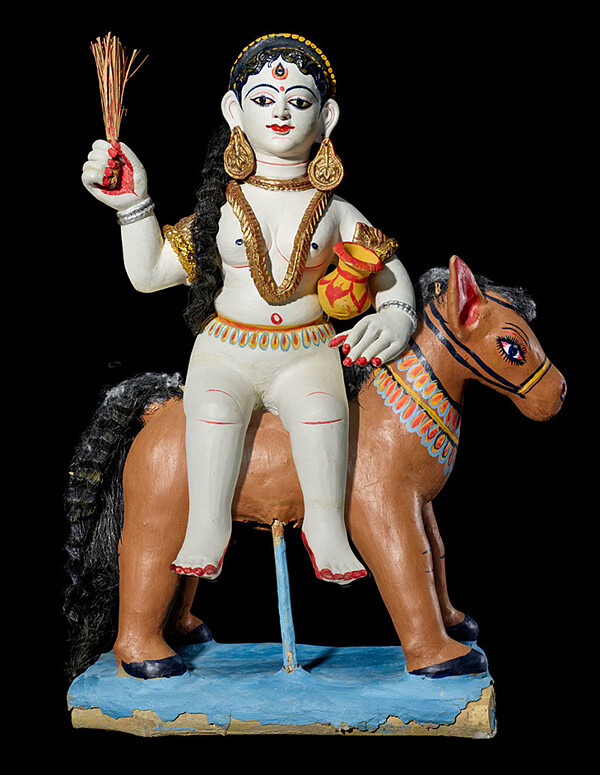
Shitala Mata, the Goddess of Smallpox. Source: National Museum of American History.
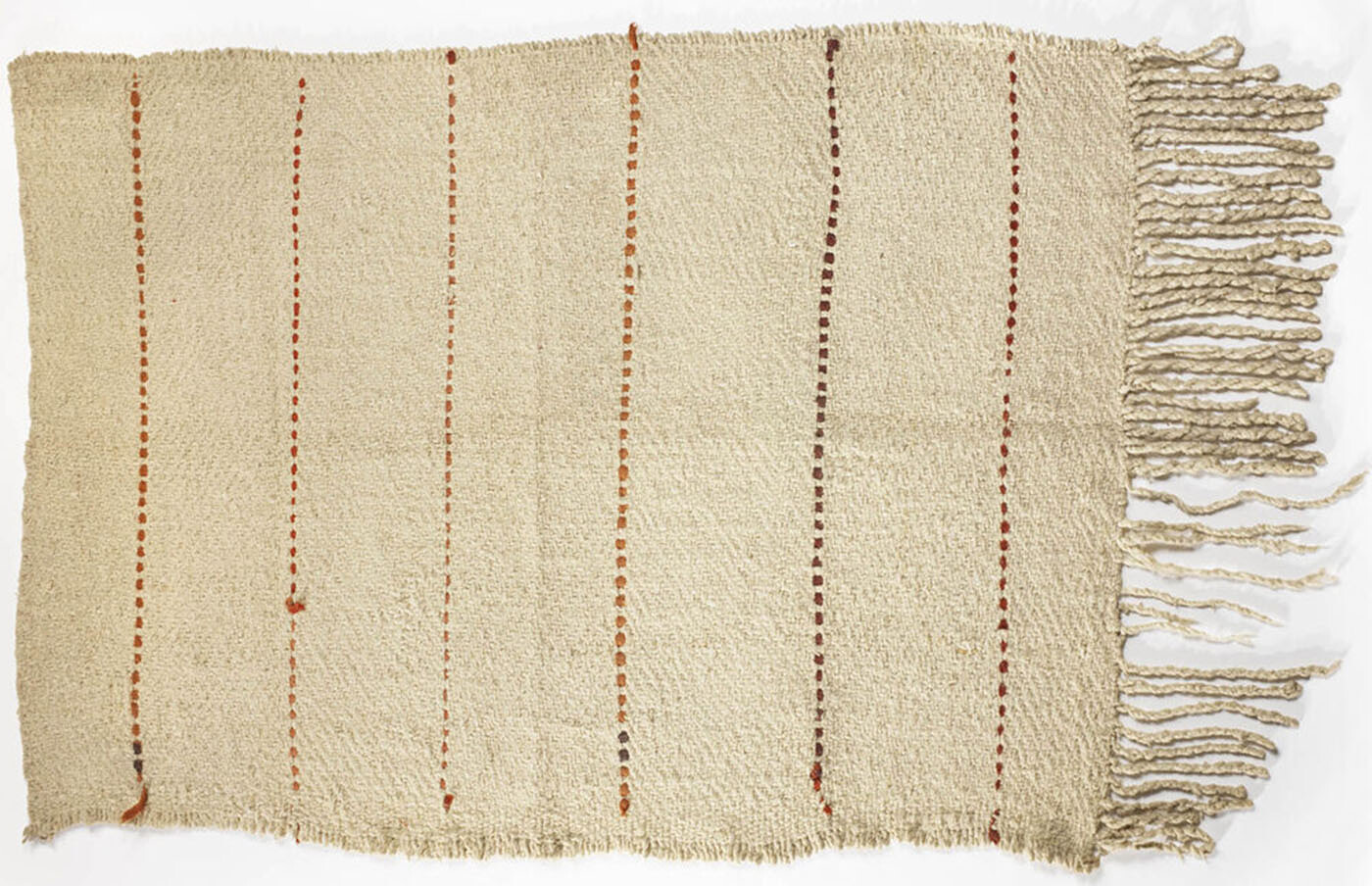
Smallpox blanket from the siege of Fort Pitt.
Shitala Mata, the Goddess of Smallpox. Source: National Museum of American History.
Contact: Colonialism and Displacement
It is helpful to think of contagion and contact in relation to settler-colonial history. Indigenous artist Elizabeth Wilson’s work in shades of red and brown brings us to a scene inside Uluru-Kata Tjuta National Park in the Central Australian Desert, where a line of artists (shown as black horseshoe shapes) is separated from a line of tourists (white horseshoe shapes) by a line of square canvases. Lurking behind the artists, unbeknownst to them, floating virus shapes envelop the scene.6 The artist welcomed Parks Australia’s decision to close the park relatively early in the coronavirus crisis. Elizabeth Wilson’s painting speaks to a long history of devastation caused by novel diseases through invading Europeans in Australia and elsewhere. The arrival of these epidemics was doubly invisible. The first epidemics often arrived in Indigenous societies across Australia and the Americas even before the inhabitants knew about the arrival of Europeans. Infections travelled easily and quickly through networks of connection along Indigenous trade routes, from body to body, unseen.
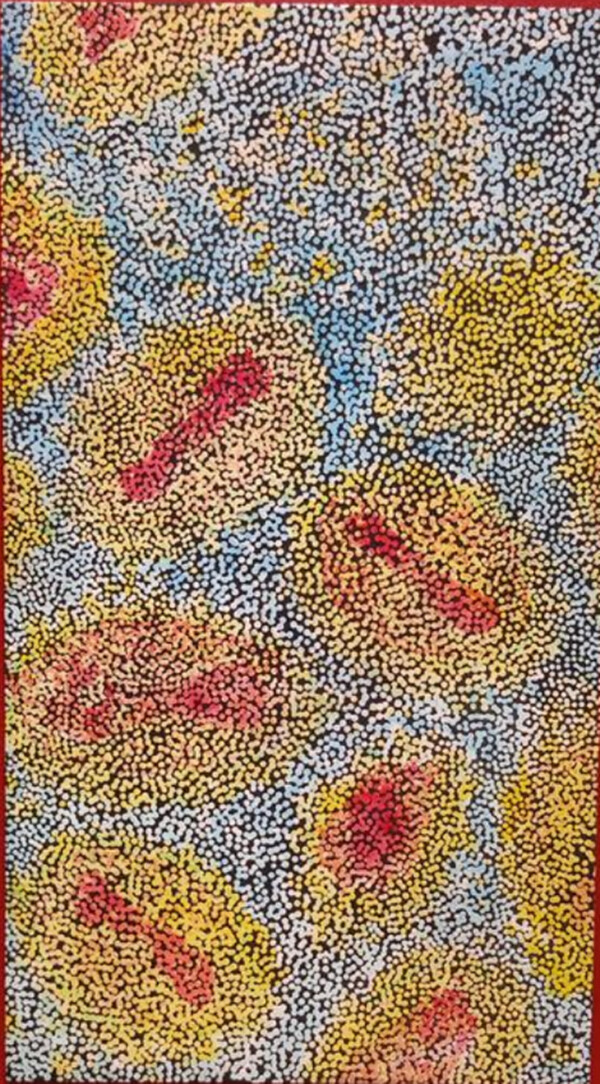

Artwork by Daniel Boyd.
Daniel Boyd, a Sydney-based Kudjala, Gangalu, Wangerriburra, Wakka Wakka, Gubbi Gubbi, Kuku Yalanji, and Bundjalung artist with ni-Vanuatu heritage, is well-known for detailed dot paintings of Indigenous leaders and Australian landscapes. In his other paintings, Boyd provides his take on the genre of European history painting, depicting Captain Cook and Joseph Banks with small details (such as Boyd’s own decapitated head in a jar that lies at Banks’s feet) that make visible the looting of land, lives, and ways of life that came with the British arrival in Australia. At the same time, Boyd returns to dot painting to render an enlarged version of a microscopic image of the smallpox virus. The European colonists who arrived in Sydney in 1788 had developed some resistance to smallpox through earlier exposure to the disease. However, First Nations peoples who they initiated contact with had not. Throughout its long history, smallpox infected vast quantities of people, killing hundreds of millions of them in the twentieth century alone. Most of those who survived were scarred, blinded, or both, and large communities of First Nations people were decimated. Boyd’s painting is a reminder that viruses such as smallpox are integral to lived experience and histories of Indigenous populations.
The visual parallels between Indigenous dot paintings and micrographs of natural structures are easy to see.7 While microscopic images expose the structural details of the natural world, allowing researchers access to scales beyond the human eye, Indigenous (Australian) paintings store stories and records of the Dreamings, portraying how the earth came into being, how the land and its creatures were created and learned to coexist. In other words, they hold an informational structure that makes space for geological and cosmic time while creating ways of knowing and seeing the world at multiple scales.
The scaling of the world from the communal, to the local, national, and global is in fact not unrelated to the speed and intensity at which viruses multiply and contagion spreads. Mutations are transcription errors that occur when RNA or DNA isn’t faithfully copied. They are part of intergenerational viral processes that intersect with other processes like capitalism and globalization. The spread of contagion is often contingent on contact, on movement, and the proliferation of bodies that global capitalism makes viable and necessary. Biologically speaking, viruses are not often considered living beings. However, they do contain genetic information coded in DNA or RNA, a characteristic shared by every other living being. This puts them in a sort of gray area. Viruses reproduce by way of collaboration—with us, or rather with human or animal cells. Virologists insist that we think about the virus not as a static particle but as a distributed process that intra-acts with host cells. We are, therefore, complicit in its multispecies reproduction and proliferation. As Stephan Guttinger and John Dupré write, viruses are living processes that “often mix with and become part of other processes and hence contribute to a number of outcomes at the same time.”8
The ability of the virus to spread with new mutations depends on social and political factors too. The Mithila region on the border between India and Nepal is well known for the artistic tradition of Mithila painting. Since independence from the British in 1947, the arts of Mithila have received Indian government support. Since the 1960s, the traditional modes of Mithila art have moved from mud walls to paper and canvas. While various Mithila artists have reflected on the situation in different ways, Getting Home, a painting by Dalit artist Naresh Kumar Paswan, shows a snippet from the Great Covid Migration in India in which laborers in cities lost their jobs and were forced to return home to their villages en masse and on foot, changing the structure of the city overnight and bringing the virus to areas that may have been unaffected until then. India’s second wave was as much about a new viral strain as it was about the government’s handling of the pandemic, a highly unequal healthcare system, a national shortage of oxygen, and state elections and rallies that continue to be held despite the rates of infection.
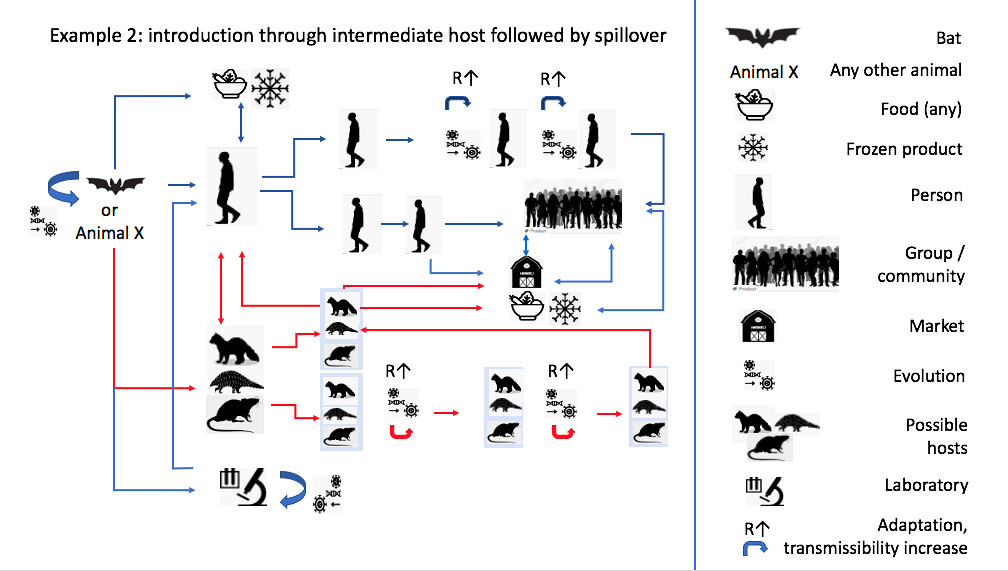

Zoonotic diagram based on phylogenetic inference, Joint WHO–China Study, 2021.
Connections: How We Make Them
As Priscilla Wald writes, “Contagion is more than an epidemiological fact. It is also a foundational concept in the study of religion and of society, with a long history of explaining how beliefs circulate in social interactions.”9 As ideas circulate, information and misinformation alike spread across communities. In the state of Bengal in India, a community of scroll painters who practice the folk art of Patachitra (literally “cloth painting”) and who have conventionally travelled from village to village and more recently to urban areas, performing their stories as they unroll their narrative scrolls, have been painting and performing stories about the virus. Swarna Chitrakar’s seven-frame scroll features in its first large frame a semi-anthropomorphized figure of the coronavirus. Painted a fiery red with radiating gray spikes all over its body, the large head of this creature is endowed with big round eyes, which also mirror the virus form we have now come to recognize. Although in their early form Patachitra paintings and performances retold mythological stories and often encapsulated certain moral values, Swarna Chitrakar and her compatriots (sometimes working with NGOs) have in recent decades made scrolls that narrate the symptoms, dangers, and measures to control infectious diseases such as tuberculosis and HIV/AIDS. While the coronavirus scrolls follow in a similar vein, no narrative is free from the hazards of the circulation of (racist) propagandist constructions. The Covid-19 scroll repeats what it has picked up on the national news and calls the coronavirus “the virus from China.”
From the very beginning, the dominant coronavirus outbreak narrative stigmatized some individuals and groups. Incidents of anti-Asian racism grew all over the world, not only in countries such as the US and the UK but also in India, where Indian communities from the northeastern parts of the country faced attacks in the country’s cities. This strongly recalls what the historian Alan Kraut has called “medicalized nativism.” Kraut describes how the stigmatizing of immigrant groups is justified by their association with communicable disease; this implies the almost superstitious belief that national borders can afford protection against communicable disease. Artists such as Amanda Phingbodhipakkiya responded to the recent bouts of anti-Asian hate. Her 2020 series “I Still Believe in Our City” features portraits of East Asian, Southeast Asian, and Black residents of New York City accompanied by anti-discriminatory messages like “I did not make you sick” and “This is our home, too.”
Making connections (from the Latin connectere, from con: “together” + nectere: “bind”) is crucial to the work of making visible how contagion is contingent on various social, political, and economic processes. In 2020, with a small seed grant and a handful of colleagues, I started the digital project Visualizing the Virus. My hope was to use visualizing as a verb to mobilize a method. To visualize is the first revolutionary step towards action in a world where much of life and its politics is invisible. I wanted Visualizing the Virus to teach us to look differently. The digital project was set up in the first place to go beyond the media narratives around Covid-19 and center facts and reflections between science and society from communities who are made invisible. It aimed to provide a granular, intersectional picture of the pandemic as it evolved—to make sense of the pandemic collaboratively and from points of views that we might not otherwise be looking through. The digital architecture of the platform invites the visitor to navigate clusters of connection, finding links between quotidian lived experience, pathologies, the natural sciences, and sociocultural critique. It provides spaces for reflection on the scales of the crisis and our current infrastructural inequalities. However, working with limited funding and a tiny team meant producing a resource that was only available in English and being unable to commission new, paid work. Over more than a year of working with various collaborators, institutions, and graduate students, it became abundantly clear that while connecting stories and ideas was viable, the ability to really center marginalized voices remained only partially fulfilled. How would we reach people who we don’t know about and who don’t know about us? Should we try to reach everyone everywhere, or is it enough to start looking?
The circulation of disease and ideas are both invisible. How we look and what we look for makes visible the simultaneous fragility and tenacity of social bonds and political formations of the conditions of living-with viruses.
Ping Yu et al., “Geographical Structure of Bat SARS-Related Coronaviruses,” Infection, Genetics, and Evolution, no. 69 (April 2019): 224–29.
Anna Lowenhaupt Tsing, Friction: An Ethnography of Global Connection (Princeton University Press, 2005), 75–76.
David Hardiman, “The Influenza Epidemic of 1918 and the Adivasis of Western India,” Social History of Medicine 25, no. 3 (August 2012): 644–64.
Howard Phillips and David Killingray, “Introduction,” in The Spanish Influenza Pandemic of 1918–19, ed. Phillips and Killingray (Routledge, 2011), xvii–xix; 8.
Rashmi Varma, “Primitive Accumulation: The Political Economy of Indigenous Art in India,” Third Text 27, no. 6 (December 2013): 748–61.
See Jeremy Eccles, “On & Off in Aboriginal Art,” Aboriginal Art Directory, April 6, 2020 →.
These parallels have recently been explored in an exhibition called “Stories and Structures,” presented by Microscopy Australia →.
John Dupré and Stephan Guttinger, “Viruses as Living Processes,” Studies in History and Philosophy of Science Part C: Studies in History and Philosophy of Biological and Biomedical Sciences, no. 59 (October 2016): 109–16.
Priscilla Wald, Contagious: Cultures, Carriers, and the Outbreak Narrative (Duke University Press, 2007), 2.
Acknowledgements: The Visualizing the Virus project was funded by DARIAH EU and the Critical Media Lab, IXDM, Basel. A few months in, I was joined by Ellen Ambrosone, the South Asia librarian at Princeton University, to steer the project. We worked with Lizzie Malcolm (Rectangle Design) to design the digital architecture in a way that allowed clusters of information to link themes and geographies in multiple ways. More information on the project and team can be found at visualizingthevirus.com.
